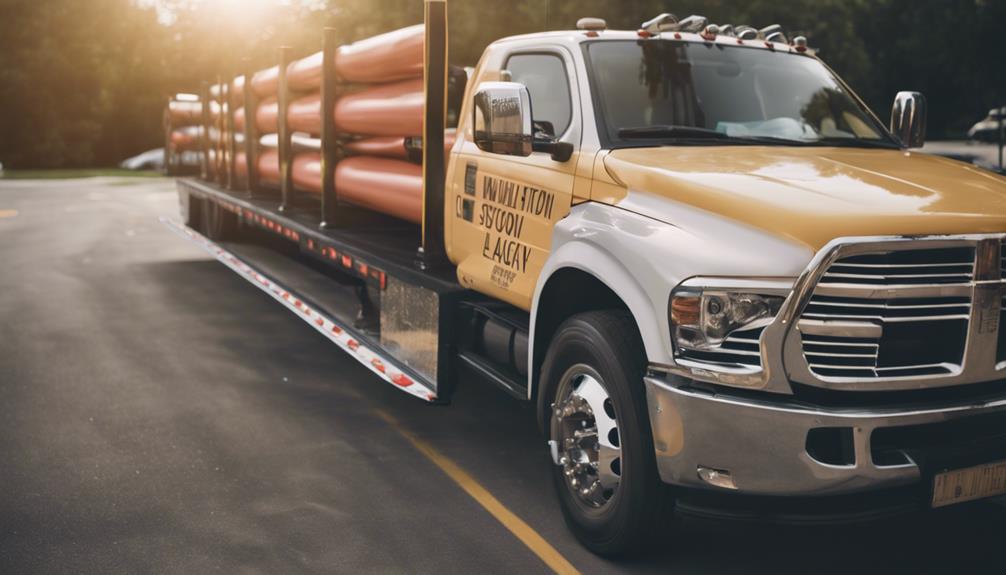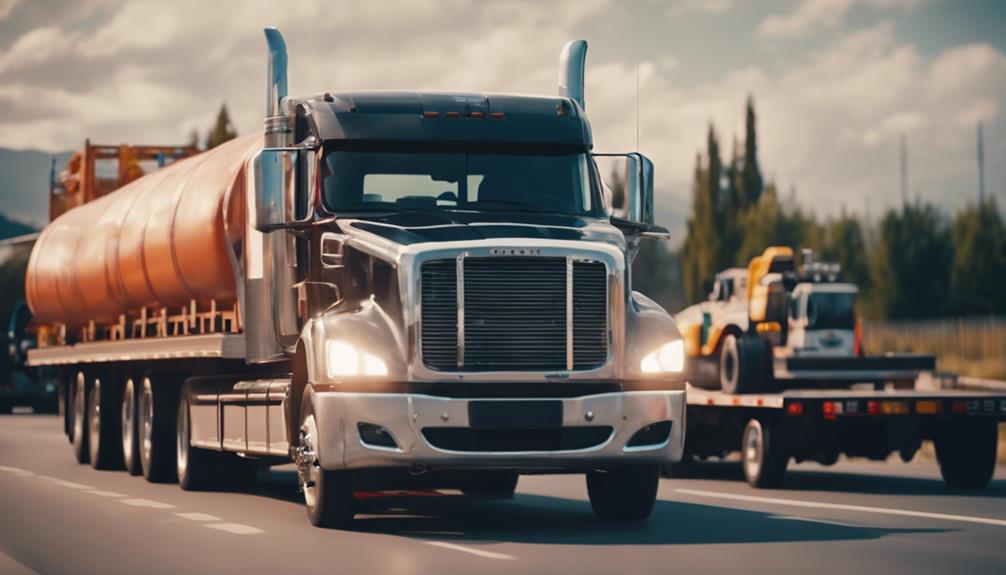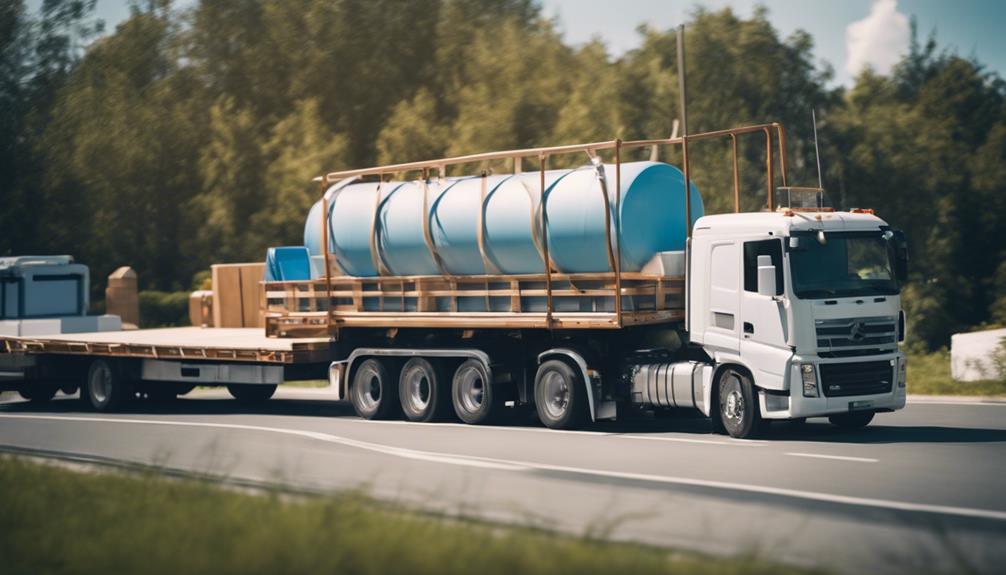When transporting a swimming pool, it is important to ensure the pool shell is secured with sturdy straps, obtain oversize shipment permits, guarantee carrier compliance with regulations, utilize escort vehicles, request freight quotes, and follow best industry practices to ensure a smooth and cost-effective transport. It is crucial to properly secure the fiberglass pool with attention to detail to prevent shifting during transit. Verify carrier permits and route restrictions for compliance, as escort vehicles are necessary for oversize pool shipments to ensure safe transit. Acquire quotes for a clear cost estimate. Failing to adhere to these practices can result in complications.
Key Takeaways
- Secure pool shell with sturdy straps.
- Obtain oversize shipment permits.
- Ensure carrier compliance with regulations.
- Utilize escort vehicles for safe transport.
- Request freight quote for cost estimation.
Secure Pool Shell Properly

To guarantee the safe transportation of a swimming pool, securely fasten the fiberglass pool shell to the flatbed truck using sturdy straps or cables.
When it comes to fiberglass pool transport, ensuring that the pool shell is properly secured is paramount. By using straps or cables in line with industry standards, you can prevent shifting or damage during transit.
The structural integrity of the fiberglass pool must be maintained through secure fastening to avoid any potential accidents or incidents on the road.
Following best practices for securing the pool shell isn't just a recommendation; it's a necessity to guarantee a safe and successful transport of the fiberglass pool. Make sure to double-check the fastenings and tighten them as needed before hitting the road.
Your attention to detail in securely tethering the pool shell will go a long way in ensuring a smooth and incident-free transportation process.
Obtain Oversize Shipment Permits

You must obtain oversize shipment permits before transporting a fiberglass pool on public roads. Each state the shipment passes through requires a different permit, so make certain you have the necessary documentation.
Make sure carrier drivers have the correct banners, flags, lights, and state permits for oversize loads to comply with regulations.
Permitting Requirements
When transporting a swimming pool, it's crucial to secure oversize shipment permits before hitting the road. Here are some key permitting requirements to keep in mind:
- State-Specific Permits: Different permits are necessary for each state the oversized load passes through during transport. Confirm that you have the required permits for every state on your route to avoid legal issues.
- Driver Equipment: Carrier drivers must have appropriate banners, flags, lights, and state permits for transporting oversized pool loads. Make sure all required equipment is in place and functioning correctly before starting your journey.
- Escort Vehicles: Escort vehicles are mandatory for accompanying oversize pool shipments. These vehicles help ensure the safety of the shipment and other road users, so be sure to arrange for them as needed.
- Driver Licensing: Regular truck drivers hauling oversize freight don't need a special license, but permits are essential. Verify that your driver has the necessary permits before setting off to transport the swimming pool.
Permit Application Process
When applying for oversize shipment permits to transport a swimming pool, it's important to understand the specific requirements set by each state along the transportation route.
Fiberglass pools necessitate oversize shipment permits to travel on public roads. To obtain these permits, carrier drivers must have appropriate banners, flags, lights, and state permits in place. Escort vehicles are mandatory for accompanying oversize loads during transport to guarantee safety and compliance with regulations.
Remember that each state along the route may have different permit requirements for oversize loads, so thorough research and adherence to individual state regulations are essential.
While regular truck drivers hauling oversize freight don't need a special license, they must strictly comply with permit regulations to avoid any legal issues during transit. Be diligent in obtaining all necessary oversize shipment permits and adhering to state-specific requirements to facilitate the smooth and lawful transportation of fiberglass pools.
Ensure Carrier Compliance With Regulations

Verify that carriers possess the necessary permits for oversize shipments on public roads. Double-check weight restrictions and confirm any route limitations.
Checking these essential aspects will guarantee compliance with regulations and contribute to the safe and legal transportation of fiberglass pools. Remember, adherence to these guidelines is vital for a successful and problem-free delivery process.
Check Carrier's Permits
To guarantee compliance with regulations, verify that the carrier possesses the required permits for oversize shipments on public roads.
- Oversize permits: Different states have varying requirements for permits, so confirm the carrier has the correct documentation for each part of the journey.
- Escort vehicles: Oversize loads necessitate escort vehicles during transport to ensure safety and compliance with regulations.
- Carrier permits: It's important that the carrier has the appropriate permits for oversize shipments to avoid legal issues and delays.
- Special license: While regular truck drivers can transport oversize freight, they don't need a special license. However, adherence to permit regulations is still mandatory.
Checking the carrier's permits is an important step in ensuring that your swimming pool transport goes smoothly. By confirming the carrier's compliance with oversize regulations, you can prevent potential problems and delays during the transportation process.
Verify Weight Restrictions
Check the weight of the fiberglass pool to confirm the carrier's adherence to regulations for oversized loads.
Carriers have specific weight restrictions for transporting heavy equipment such as fiberglass pools in shipping containers. Exceeding these weight limits can lead to additional fees or delays in transport, impacting the cost to ship.
It's vital to verify that the weight of the pool is within the carrier's specified limits to prevent any issues during transportation. Confirming the weight of the pool beforehand will help maintain compliance with regulations and contribute to a smooth and cost-effective pool transport process.
Confirm Route Restrictions
Verifying route restrictions is essential to guarantee carrier compliance with regulations when transporting a swimming pool. To make sure carrier complies with regulations, follow these steps:
- Check for any route limitations: Before starting the journey, be sure to examine all possible restrictions that could impact the transportation of the swimming pool. This includes evaluating any narrow roads, low bridges, or weight restrictions along the route.
- Confirm compliance with state regulations: It's vital to make certain that carriers adhere to state regulations concerning oversized loads and obtain any necessary permits for transportation.
- Understand specific requirements: Familiarize yourself with the specific requirements for escort vehicles and safety measures that need to be in place during the transport of an oversized load like a swimming pool.
- Verify route accommodation: Confirm that the chosen route can accommodate the size and weight of the swimming pool being transported to avoid any logistical issues or delays due to route restrictions.
Accompany With Escort Vehicles

For safe transportation on public roads, oversize fiberglass pool shipments must be accompanied by escort vehicles. State regulations mandate the use of escort vehicles for oversize loads, including the transport of fiberglass pools. These escort vehicles play an important role in ensuring the safety of the shipment. By alerting other drivers to the presence of a large load on the road, they help minimize potential risks and accidents. Additionally, escort vehicles provide extra visibility and assistance during the transportation of heavy pool shells, aiding in a smooth and secure journey.
The presence of properly equipped escort vehicles is essential for the successful transport of oversize fiberglass pools. Their role goes beyond mere guidance; they serve as a protective measure, ensuring that the pool reaches its destination without incidents. Therefore, when planning to transport a swimming pool, it's imperative to adhere to state regulations and have escort vehicles accompany the shipment to guarantee a safe and efficient journey.
Get Freight Quote for Cost Understanding

To gain a clear understanding of the costs involved in transporting a fiberglass pool, it's advisable to request a freight quote. Here are a few key points to keep in mind when seeking a freight quote for transporting fiberglass pools:
- Factors Impacting Cost: Distance, weight, dimensions, and permits all play a role in determining shipping costs for transporting a swimming pool.
- Planning and Budgeting: Obtaining a freight quote allows for better planning and budgeting, ensuring you're prepared for the associated expenses.
- Additional Expenses: Fuel costs, border crossings, and seasonality can also influence the overall shipping costs of transporting a swimming pool.
- Accurate Cost Estimate: Getting a freight quote provides an accurate estimate of the total expenses involved in transporting a fiberglass pool, helping you make informed decisions regarding the transportation process.
Follow Best Practices for Smooth Transport

Securing the fiberglass pool shell on a flatbed truck with sturdy straps or cables is vital for a smooth transport experience. When dealing with oversize loads like fiberglass pools, it's important to work with reputable shipping companies that understand the intricacies of transporting such items. These companies can assist in obtaining the necessary transportation permits for moving oversize loads on public roads. Additionally, escort vehicles are often required to accompany oversize loads to ensure safe transport.
When arranging the transportation of a fiberglass pool, factors such as fuel costs, distance, weight, dimensions, and transportation permits all play a role in determining the overall cost. To get a precise estimate, it's advisable to request a freight quote from the shipping company.
Frequently Asked Questions
How Hard Is It to Move an Inground Pool?
Moving an inground pool is a complex task that requires professional expertise. It involves draining water, disconnecting utilities, and excavating the pool shell.
The process can be challenging due to the heavy structure and coordination needed with utility companies and local authorities. Costs vary based on size, distance, and additional services.
Proper planning and hiring experienced professionals are essential for a successful and safe inground pool move.
Can You Take Down an Above Ground Pool and Move It?
You can indeed take down an above ground pool and move it to a new location. Proper planning and coordination are essential for disassembly, which involves draining the pool, removing the liner, and dismantling the frame.
Labeling and organizing all parts during disassembly is critical to guarantee a smooth reinstallation process. Careful handling during both disassembly and reinstallation helps prevent any damage to the pool components.
How Should We Move Around the Swimming Pool?
When moving around a swimming pool, make sure the area is clear of obstacles for safe navigation.
Use protective covers to prevent damage.
Employ pool dollies or wheeled carts for efficient movement without straining workers.
Communicate effectively with the transport team for smooth coordination.
Prioritize safety by securing the pool on the transport vehicle to prevent shifting or damage during transit.
Follow these steps to move the pool safely and efficiently.
How to Transport an Above Ground Pool?
To transport an above ground pool, start by disassembling it, draining the water, and securely packing all components. Properly securing the pool walls, liner, and equipment is crucial to prevent damage during transit.
Depending on the pool's size and weight, use a truck or trailer for transportation. When reassembling the pool at the new location, guarantee precise alignment and leveling for best functionality.
Transporting an above ground pool requires careful planning and execution.
What are the best practices for transporting swimming pools to avoid negative reviews?
When transporting swimming pools, it’s crucial to follow best practices to avoid ending up with the worst reviewed swimming pools. Properly securing the pool, using the right equipment, and planning the route carefully can prevent damage and ensure a smooth delivery. Investing in professional transportation services is also a wise decision.
What are the Best Practices for Extending the Lifespan of a Transported Swimming Pool?
Properly covering and securing a transported swimming pool can significantly extend its lifespan. Regular maintenance checks and chemical balancing are also essential for extending swimming pool knowledge. Additionally, handling the pool with care during transportation and following manufacturer guidelines can help ensure its longevity.
How can I transport and extend my swimming pool safely and effectively?
When looking to transport and extend your swimming pool safely and effectively, it’s important to consider extending swimming pool essentials like proper support and reinforcement for the structure. Make sure to use durable materials and consult with professionals to ensure a secure and successful extension process.
What Are the Best Practices for Transporting and Extending a Swimming Pool?
When it comes to extending your pool knowledge, it’s important to follow best practices for transporting a swimming pool. Make sure to drain the pool completely, disassemble it properly, and secure all components for travel. Also, consider hiring professionals to assist with the process to ensure a smooth and safe relocation.
Can the Best Practices for Transporting a Swimming Pool Also Apply to Extending a Swimming Pool?
When it comes to extending swimming pool knowledge, the best practices for transporting a swimming pool can also apply. Proper planning, securing necessary permits, hiring experienced professionals, and following safety guidelines are essential for both tasks. Understanding the logistics and regulations will ensure a successful outcome for any pool-related project.
Conclusion
As the pool shell is secured and the oversize shipment permits obtained, the journey begins.
With carrier compliance, escort vehicles, and a clear freight quote in hand, the transport is set to go smoothly.
Follow these best practices to guarantee your swimming pool arrives safely and securely at its destination.
The anticipation builds as the pool makes its way down the road, ready to bring joy and relaxation to its new home.










